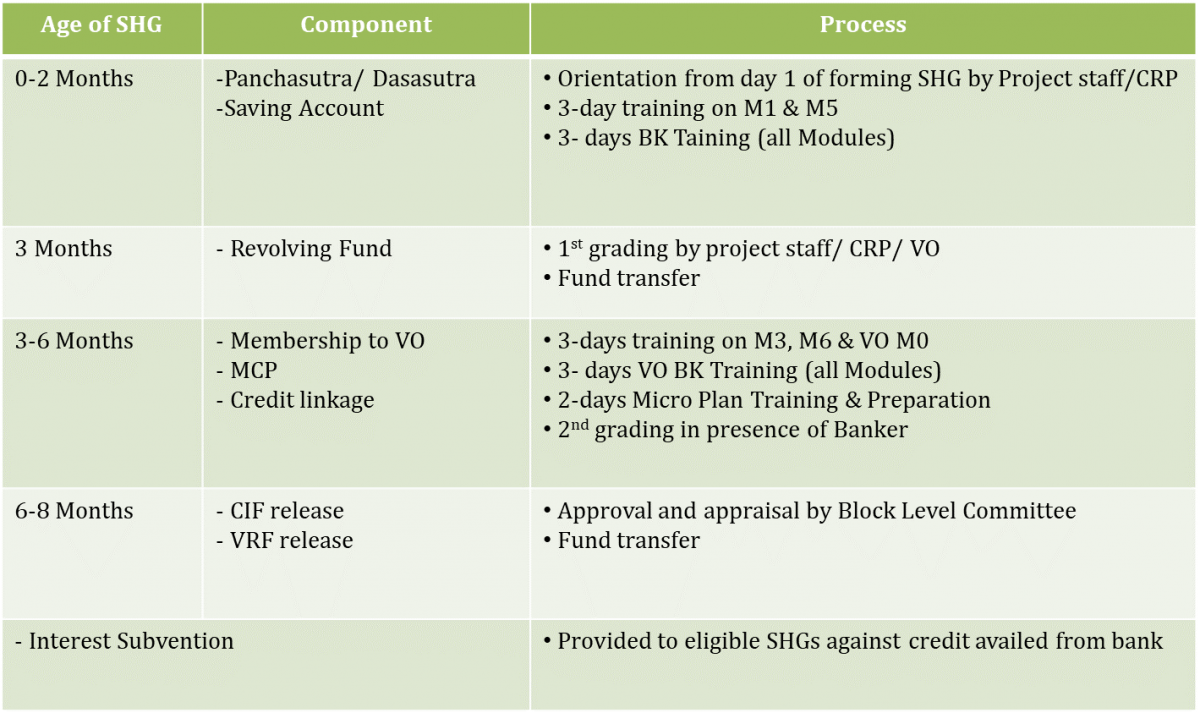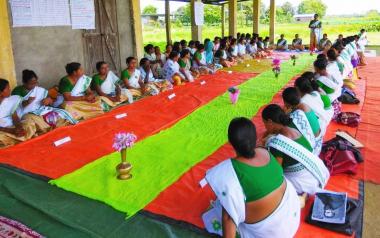Deendayal Antyodaya Yojana (DAY-NRLM) is a holistic self- employment programme for the rural poor with a time bound and outcome based approach which envisages to encompass the entire gamut of social issues and to pave the way for the poor; so that they become capable of coming out of poverty through universal social mobilization, forming and strengthening of SHGs and their federations, capacity building, financial inclusion, access to credit, skill development and taking up different livelihoods options supported with provisions of technological as well as marketing support.
Universal Social Mobilisation
The Process:
First step: Collection of authentic Household data of village
Second step: Conduct a Pre-concept seeding meeting with villagers.
Purpose for conducting Pre-concept seeding meeting: To help the community in order to understand the need for SHG especially pre-existing SHGs from other programme which have either became defunct or have anomaly in SHG functioning.
Process for conducting the meeting: At the beginning of the meeting the facilitator need to introduce himself/herself, identify challenges in the life of a poor family through discussion with the participants and who can address these issues.
Third step: After 1 week or so from the pre-concept seeding meeting, the facilitator need to conduct the Concept seeding meeting for formation of SHG.
Purpose of conducting concept seeding meeting: Explaining participants on why the meeting is conducting.
Introduction & recap: Summary of the previous meeting to be elaborated so that participants can able to recollect their challenges etc. which were highlighted in the previous meeting.
Sharing success stories: Showcase nearby best performing SHG to the participants so that participants are self-motivated towards forming/reviving SHG.
Open house discussion: Involving all the participants to address the issues they were highlighting in the previous meeting.
Conclusion of the meeting: After reasons & clarifications, lead the participants towards a final decision. Participants will finally decide if they want to form an SHG(s) or not.
Additional steps while reviving old SHG:
First step: As first step, financial audit of the concerned dormant SHG needed.
Second step: After the first step, any of the actions may be taken:
Institution Building
ASRLM invests in building ‘Social Capital’ – Jeevika Sakhis/Community Resource Persons, Master Book Keepers, MCP Trainers, Bank Mitra, Krishi Sakhis, Pashu Sakhis, Bank Sakhis etc., who are crucial in making NRLM community driven and sustainable.

Capacity Building
Focus is made to develop and engage community professionals and community resource persons (CRP) for capacity building of SHGs and their federations and other collectives.

| SN | Name of Orientation/Training Program | Duration of Training |
| 1 | Orientation Programme to ASRLM Officials | 1- 5 days |
| 2 | Induction Programme to new recruits under ASRLM | 4 days |
| 3 | ToT on SHG Concept & Management training Modules | 3 days |
| 4 | ToT on VO Concept & Management training Modules | 2 days |
| 5 | ToT on CLF Concept & Management training Modules | 2 days |
| 6 | ToT on Active Women Induction Programme | 5 days |
| 7 | ToT on SHG & VO Book of Records | 3 days |
| 8 | ToT on CLF Book of Records | 3 days |
| 9 | Active Women Induction Programme for Jeevika Sakhi (iCRP) development | 15 days |
| 10 | Refresher Training to Jeevika Sakhis on SHG Concept & Management training Modules | 1-3 days |
| 11 | Refresher Training to Jeevika Sakhis on VO Concept & Management training Modules | 1-3 days |
| 12 | Refresher Training to Jeevika Sakhis on CLF Concept & Management training Modules | 1-3 days |
| 13 | Refresher Training to Jeevika Sakhis on SHG & VO Book of Records | 1-3 days |
| 14 | Refresher Training to Jeevika Sakhi on CLF Book of Records | 1-3 days |
| 15 | Initiation Training on Mobilisation, PIP & Promotion of SHG to District/Block officials | 1-2 days |
| 16 | Initiation Training on Mobilisation, PIP & Promotion of SHG to Jeevika Sakhis | 1-3 days |
| 17 | SHG Concept & Management | 3 days |
| 18 | SHG Basic Management Training Module | 3 days |
| 19 | VO Concept to SHG, Leadership Visioning & Planning Exercise & VO Formation | 3 days |
| 20 | VO Basic Management Training | 3 days |
| 21 | SHG Book Keepers Training | 3 days |
| 22 | VO Book Keepers Training | 3 days |
| 23 | CLF Concept & Leadership, Visioning & Planning Exercise Training (CLF M1- Part 1, M6) to CLF EC & OB/ VO EC | 2 days |
| 24 | CLF Basic Management Trainings | 3 days |
| 25 | ToT on SOP of VO & CLF | 3-5 days |
| 26 | Training on SOP of VO & CLF to district/Block officials | 3-5 days |
| 27 | MCP Trainers Training | 2 days |
| 28 | MBK Trainers Training | 3 days |
| 29 | MCP Training | 2 days |
| 30 | MBK Training | 3 days |
| 31 | Bank Sakhi Training | 3 days |
| 32 | Bank Sakhi Refresher Training | 1 day |
| 33 | Bank Mitra(BCA) Training | 3 days |
| 34 | Bankers' Training/ Sensitization on NRLM | 1-3 days |
| 35 | Training to CBRM Committee | 1 day |
| 36 | ToT on Financial Literacy | 7 days |
| 37 | FNHW Training | 3 days |
| 38 | Gender Mainstreaming Training | 3 days |
